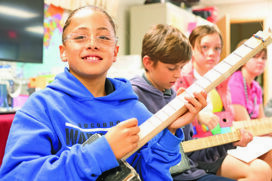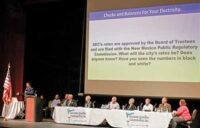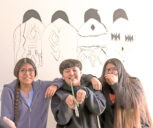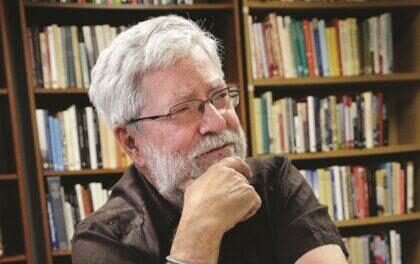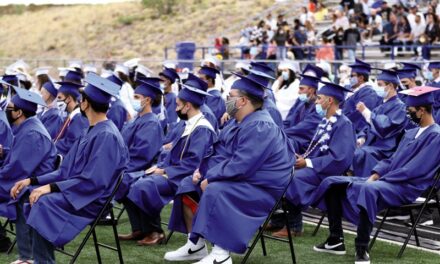
This may seem like an ordinary scene for music students in New Mexico, except for their unique instruments. The students are playing their own hand-made electric cigar box guitars.
“The students really enjoy the hands-on part of building their own guitar,” Beth Crowder CVC music teacher said. “For many, this is the first instrument they have ever learned to play, and as we all know, learning an instrument takes a lot of patience.”
Crowder said it all began in 2013 when she realized that she needed to do something else besides singing in her music class.
“I was looking around for a hands-on project and my friend, Kate Burleigh, said she had a book on how to build instruments. So, the first go-round the sixth graders got into four groups, each group building a different type of instrument. One of those groups built a pizza box guitar,” Crowder said.
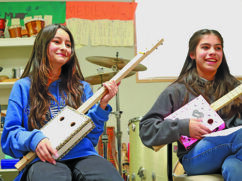
“Jim and his friend felled a Sassafras tree, milled it into boards, and he cut the boards into the first necks that we used in the fall of 2014,” Crowder said. “Our first cigar box guitars had screw-eyes for tuners, and they worked but were hard to tune. We used weed whacker string for the strings. Each year we have improved the guitars and now they have real guitar tuners, real strings and even piezo pickups.”
The project begins with several class periods dedicated to tool safety, then the students have a measuring lab and learn simple math skills to help them with the construction. Students watch a video on how a tree is felled and milled into boards, to help them understand the materials they are using.
“They begin measuring and marking where the tuners go, the bridge, the nut, the string holes, the placement of the box, the notch in the box where the neck passes through, sound holes, and more.” Crowder said. “Once everyone has their necks and boxes marked, then we host a ‘Build it Day’ at school where a team of fearless volunteers come with their tools.”
Students rotate through five stations and the guitars are built that day, with the help of community volunteers. Jim Ruff cuts the necks for the guitars, Jon Spargo and the HAM radio club build the piezo pickups, the school buys the guitar tuners and strings, and many people donate cigar boxes. The art teacher guides the students with decorating and painting their guitars. It takes a dozen or so volunteers to work together to make it happen.
“These guitars can be plugged into an amp and this year was extra special because Jeff Havlena cut fretboards and taught me how to put fret wire on them, which I, in turn, taught to whomever wanted to make one. This is the first time any student has had the opportunity to put a real fretboard on their guitar.” Crowder said.
Crowder believes that hands-on STEM projects and music education offer opportunities for students and helps develop their imagination and math skills.
“This type of active learning has been shown to promote retention, much more so than passive learning.
“A hands-on project like this is effective because the students take control of their learning and gives them an increased feeling of ownership.” Crowder said.
